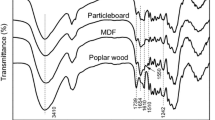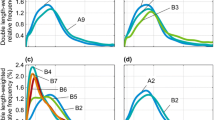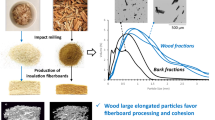Abstract
Since different test methods of measuring the formaldehyde emission (FE) from wood-based composite panels have been used for different countries and regions, this study attempted to establish empirical correlations between three test methods (i.e., 24-hour desiccator, 1 m3 chamber, and perforator) for plywood (PLW), particleboard (PB), and medium density fiberboard (MDF), particularly emphasizing on correlations between the 24-hour desiccator and the 1 m3 chamber method. The desiccator method found statistically high correlations with other two methods, resulting in regression coefficient values ranging from 0.96 to 0.88 for PLW, PB, and MDF samples. In particular, the desiccator method had an empirically high correlation with the 1 m3 chamber method that had been adopted as the reference method of comparing regionally different test methods of measuring the FE of wood-based composite panels by the ISO/TC89.
Zusammenfassung
Da in verschiedenen Ländern und Regionen unterschiedliche Prüfmethoden zur Messung der Formaldehydabgabe (FE) von Holzwerkstoffplatten verwendet werden, wurde in dieser Studie der Versuch unternommen, empirische Korrelationen zwischen den drei Prüfmethoden, 24-Stunden Desiccator, 1 m3 Prüfkammer und Perforator, für Sperrholz (PLW), Spanplatten (PB) und mitteldichte Faserplatten (MDF) zu bestimmen. Dabei wurde besonderes Gewicht auf die Korrelation zwischen dem 24-Stunden Desiccator-Verfahren und dem 1 m3 Prüfkammer-Verfahren gelegt. Das Desiccator-Verfahren war statistisch hoch mit den beiden anderen Verfahren korreliert. Die Regressionskoeffizienten der PLW-, PB- und MDF-Proben lagen zwischen 0,96 und 0,88. Insbesondere das Desiccator-Verfahren wies eine hohe Korrelation mit dem 1 m3 Prüfkammer-Verfahren auf, das von ISO/TC89 als Referenzverfahren zum Vergleich regional unterschiedlicher Prüfverfahren zur Messung der Formaldehydabgabe von Holzwerkstoffen übernommen worden war.





Similar content being viewed by others
References
Bulian F, Battaglia R, Ciroi S (2003) Formaldehyde emission from wood based panels: The importance of intercalibrating the test methods. Holz Roh- Werkst 61:213–215
Dunky M (1998) Urea-formaldehyde (UF) adhesive resins fro wood. Int J Adhes Adhes 18:95–107
Lehmann WF (1982) Correlations between various formaldehyde tests. In: Proc of the 16th international symposium on particleboard. Washington State University, Pullman, pp 35–44
Marutzky R (1989) Release of formaldehyde by wood products. In: Pizzi A (ed) Wood adhesives: chemistry and technology, vol 2. Dekker, New York, pp 307–387
Marutzky R, Margosian R (1995) Measuring formaldehyde emissions from pressed wood products: an international perspective. In: Measuring and controlling volatile organic compound and particulate emissions from wood processing operations and wood-based products. The Forest Products Society, Madison, pp 62–73
Myers GE (1983) Formaldehyde emission from particleboard and plywood paneling: measurement, mechanism and product standards. For Prod J 33(5):27–27
Myers GE (1984) Effect of ventilation rate and board loading on formaldehyde concentration: a critical review of the literature. For Prod J 34(10):59–68
Myers GE (1985a) Effect of temperature and humidity on formaldehyde emission from UF-bonded boards: a literature critique. For Prod J 35(9):20–31
Myers GE (1985b) Effect of separate conditions to furnish or veneer on formaldehyde emission and other properties: a critical review. For Prod J 35(6):57–62
Meyer B, Hermanns K (1985) Formaldehyde release from pressed wood products. In: Turoski V (ed) Formaldehyde: analytical chemistry and toxicology. Advances in chemistry series, vol 210. American Chemical Society, Washington, pp 101–116
Myers GE, Nagaoka M (1981) Emission of formaldehyde by particleboard: effect of ventilation rate and loading on air-contaminating levels. For Prod J 31(7):39–44
Que Z, Furuno T (2007) Formaldehyde emission from wood products: relationship between the values by the chamber method and those by the desiccator test. Wood Sci Technol 41:267–279
Que Z, Furuno T, Katoh S, Nishino Y (2007) Evaluation of three test methods in determination of formaldehyde emission from particleboard bonded with different mole ratio in the urea-formaldehyde resin. Build Environ 42:1242–1249
Risholm-Sundman M, Wallin N (1999) Comparison of different laboratory methods for determining the formaldehyde emission from three-layer parquet floors. Holz Roh- Werkst 57:319–324
Risholm-Sundman M, Larsen A, Vestin E, Weibull A (2005) Formaldehyde emission—a comparison of different standard methods. In: Proc Indoor Air, pp 1925–1930
Sundin EB, Mansson B, Endrody E (1987) Particleboard with different contents of releasable formaldehyde: a comparison of the board properties including results from four different formaldehyde tests. In: Proc of the 21st international particleboard/composite materials symposium. Washington State University, Pullman, pp 139–186
Wiglusz R, Jarnuszkiewicz I, Sitko E, Nikel G (2000) Interlaboratory comparison experiment on the determination of formaldehyde emitted from mineral wood board using small test chambers. Build Environ 35:53–57
Acknowledgement
The authors appreciate partial financial support from the Ministry of Environment, Republic of Korea for a part of this work (plywood experiment).
Author information
Authors and Affiliations
Corresponding author
Rights and permissions
About this article
Cite this article
Park, BD., Kang, EC., Park, SB. et al. Empirical correlations between test methods of measuring formaldehyde emission of plywood, particleboard and medium density fiberboard. Eur. J. Wood Prod. 69, 311–316 (2011). https://doi.org/10.1007/s00107-010-0446-6
Received:
Published:
Issue Date:
DOI: https://doi.org/10.1007/s00107-010-0446-6




